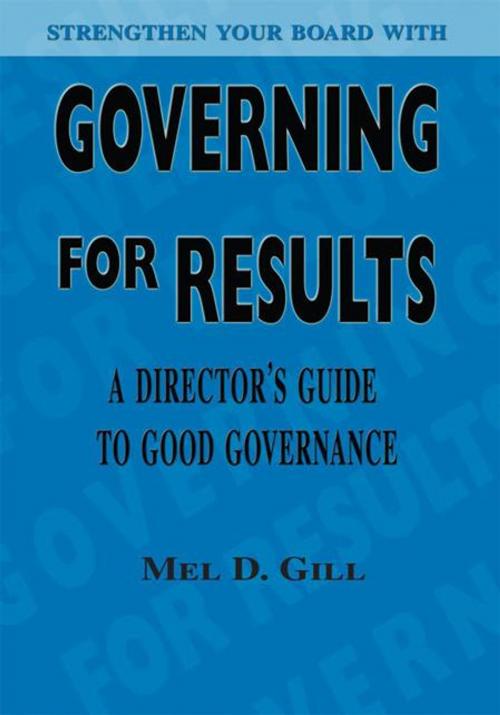Governing for Results
A Director's Guide to Good Governance
Business & Finance, Management & Leadership, Leadership| Author: | Mel D. Gill | ISBN: | 9781466954922 |
| Publisher: | Trafford Publishing | Publication: | August 13, 2007 |
| Imprint: | Trafford Publishing | Language: | English |
| Author: | Mel D. Gill |
| ISBN: | 9781466954922 |
| Publisher: | Trafford Publishing |
| Publication: | August 13, 2007 |
| Imprint: | Trafford Publishing |
| Language: | English |
BEST SELLER
This BEST SELLIING book provides a comprehensive guide to effective governance for board members and their senior executives. The author offers a new framework for understanding boards and proposes practices that boards can use to fulfill their stewardship responsibilities, strengthen board performance and improve organizational effectiveness. The book discusses the basics of governance - what it is and why it matters; essential duties and liabilities of the board and its members; and the essentials of an effective board/management partnership.
It provides detailed guidance on the seven primary areas of board responsibility: i) mission and planning; ii) financial stewardship; iii) human resources stewardship; iv) performance monitoring and accountability; v) community representation and advocacy; vi) risk management; and, vii) managing 'critical events' and 'transitional phases'. It discusses the legal structure of nonprofits, who owns them and how to organize for accountable governance.
Governing for Results will assist boards in dealing with recurring issues around board and committee structures; their terms of reference and effective use; and job descriptions for key officers. The discussion of board development, board management, decision-making and organizational culture will prove invaluable in helping many boards deal with these complex issues. A discussion of the essential principles of governing for results includes a logical framework for planning and evaluation.
The book provides tools that can help boards decide which governance practices will best fit their particular organization and strengthen their performance as a governing body. It outlines the factors that may interfere with a board's ability to adopt appropriate governance practices and presents twelve keys to successful governance that were identified through research. It offers a sample letter of agreement for new board members, and samples of an agenda for board meetings, an oath of confidentiality, a values statement, conflict of interest and donor confidentiality policies, a template for financial monitoring, self-assessment tools for the board and individual directors and a basic guide to 'Rules of Order' for conduct of meetings. It also provides outlines for comprehensive by laws and governance policies, and references to additional resources.
Although this book is intended to fill a gap in the resources available to volunteer members of nonprofit boards of directors, much of its guidance will also be useful for directors of public and private sector corporations. The strong research base underpinning this work also makes it of interest to researchers, academics, and consultants. It adds perspective to the debate about governance models and offers guidance to board members with respect to board structure, responsiblities, governance practices, and problems that commonly afflict boards. It is designed as a user-friendly guide for busy directors and executives who want concise, compact and well-researched answers to perennially troubling questions about governance, the role of boards and their relationship to staff.
BEST SELLER
This BEST SELLIING book provides a comprehensive guide to effective governance for board members and their senior executives. The author offers a new framework for understanding boards and proposes practices that boards can use to fulfill their stewardship responsibilities, strengthen board performance and improve organizational effectiveness. The book discusses the basics of governance - what it is and why it matters; essential duties and liabilities of the board and its members; and the essentials of an effective board/management partnership.
It provides detailed guidance on the seven primary areas of board responsibility: i) mission and planning; ii) financial stewardship; iii) human resources stewardship; iv) performance monitoring and accountability; v) community representation and advocacy; vi) risk management; and, vii) managing 'critical events' and 'transitional phases'. It discusses the legal structure of nonprofits, who owns them and how to organize for accountable governance.
Governing for Results will assist boards in dealing with recurring issues around board and committee structures; their terms of reference and effective use; and job descriptions for key officers. The discussion of board development, board management, decision-making and organizational culture will prove invaluable in helping many boards deal with these complex issues. A discussion of the essential principles of governing for results includes a logical framework for planning and evaluation.
The book provides tools that can help boards decide which governance practices will best fit their particular organization and strengthen their performance as a governing body. It outlines the factors that may interfere with a board's ability to adopt appropriate governance practices and presents twelve keys to successful governance that were identified through research. It offers a sample letter of agreement for new board members, and samples of an agenda for board meetings, an oath of confidentiality, a values statement, conflict of interest and donor confidentiality policies, a template for financial monitoring, self-assessment tools for the board and individual directors and a basic guide to 'Rules of Order' for conduct of meetings. It also provides outlines for comprehensive by laws and governance policies, and references to additional resources.
Although this book is intended to fill a gap in the resources available to volunteer members of nonprofit boards of directors, much of its guidance will also be useful for directors of public and private sector corporations. The strong research base underpinning this work also makes it of interest to researchers, academics, and consultants. It adds perspective to the debate about governance models and offers guidance to board members with respect to board structure, responsiblities, governance practices, and problems that commonly afflict boards. It is designed as a user-friendly guide for busy directors and executives who want concise, compact and well-researched answers to perennially troubling questions about governance, the role of boards and their relationship to staff.















